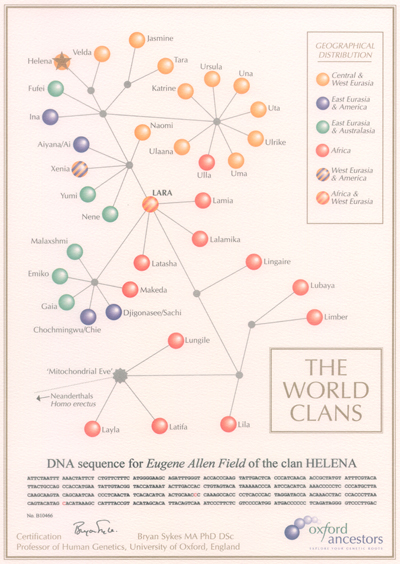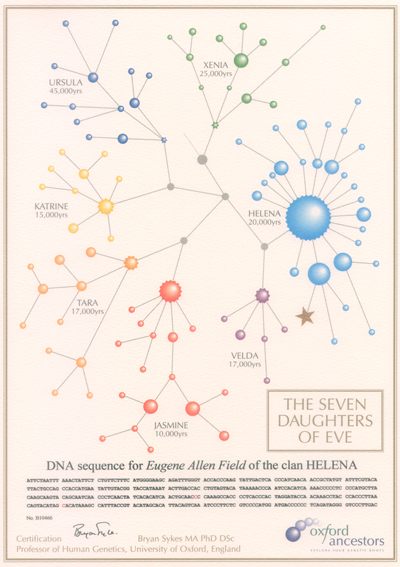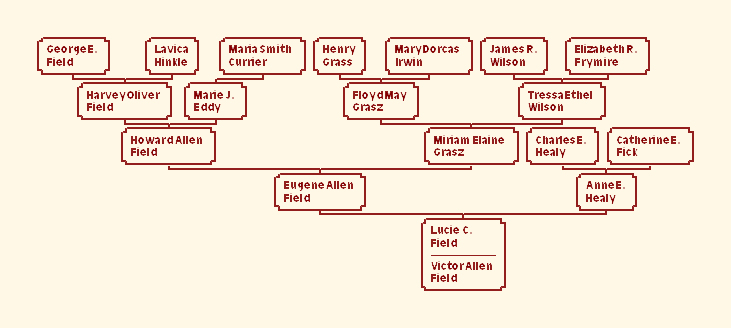
|
Genes and Genealogy: What does it mean to be related? |
|
|
Chromosome Inheritance: |
|
|
To say that any two people are related really means that they share common ancestors: parents, grandparent, great-grandparents and so on. A deeper meaning of the term related means that two people share genetic material. Each of us inherits 23 chromosomes from each parent. That gives us 46 chromosomes which contain the detailed information to make each of us a unique individual. These 46 chromosomes were in the very first cell from which we started. As we develop from that first cell originating from the union of our father’s sperm cell and our mother’s egg cell, these 46 chromosomes replicated and replicated again and again precisely distributing themselves to every new cell. The result is that every cell in our bodie has a copy of these first 46 chromosomes. No two people have the same combination of chromosomes unless they are identical twins. |
|
|
Each of these chromosomes carries specific bits of information to gives us our physical, behavioral and chemical characteristics. |
|
|
If we look a little deeper into chromosome inheritance it begins to get a bit more complicated. Nature works to make every individual as different as possible. Each of our parents had 2 sets of 23 chromosomes. One that they got from each of their parents, our grandparents. Chromosomes exist in pairs. So, our father’s 46 chromosomes were actually 2 sets of 23 he got from each of his parents. When cells were prepared to pass our father’s chromosomes on to us, a special kind of cell division took place that cut the 46 number down to 23. This is not just any 23 of his 46 chromosomes it is a specific 23 that make up a complete set. Probability tells us that half of the 23 should be from his father (your grandfather) and the other half should be from his mother (your grandmother). However, the way the process works any one of our father’s sperm cells could have carried any combination of his mother and father’s chromosomes. There is a possibility, however slight, that some of his sperm cells carried none of his father’s chromosomes and all from his mother or 1 from his father and 22 from his mother or any other combination all the way to none from his mother and all from his father. |
|
|
This same process took place in the production of your mother’s egg cell. The laws of probability tell us that we are most likely made from a combination of chromosomes equally derived from all 4 grandparents. However, the possibility does exist that a person could be a combination of only his two grandfather’s chromosomes! Our degree of relatedness to any one grandparent is a matter of chance. Through DNA analysis it could be determined just what proportion of a person’s DNA is from each grandparent. Another outcome of this shuffling of chromosomes could, by chance, result in two cousins (who share a set of grandparents) who might not have even a single chromosome in common. The further away in generations an ancestor is the less are the chances of inheriting chromosomes from that person. So, even thought you descend directly in an unbroken line from William the Conqueror the chances that you have even one of his chromosomes is very remote. |
|
|
The Y Chromosome: |
|
|
There are however, two other very interesting facts about the inheritance of DNA. The first concerns the Y chromosome. This is a short chromosome with only a few genes on it. Only males are in possession of a Y chromosome. Another interesting fact about the Y chromosome is that it is passed directly from father to son. Assuming that a woman produces children all fathered by the same man each of the brothers has his father’s Y chromosome. |
|
|
Few things about humans are as set in stone as this fact. Males inherit their father’s Y chromosome and the line goes back unbroken as far as you care to believe it goes back. So, if you are a male descendant of William the Conqueror and assuming that all of your female ancestors in that direct line were faithful to their husbands you do have at least one verifiable chromosome from William. To prove this a sample of William’s DNA would have to be obtained and the Y chromosome analyzed and compared with yours and if it is a match then William is your ancestor....well maybe! This is because Williams brothers, his father's brothers and his male cousins from his father’s brother’s also carry the same Y chromosome as well as William himself. Any relative descending from the same male line as William has the same Y chromosome. If you are a male and your Y chromosome is identical to William’s the only certain conclusion that can be stated is that if you are not a direct descendant of William you have a common male ancestor. |
|
|
Mitochondrial DNA - mtDNA: |
|
|
The second interesting fact about the inheritance of DNA is through the female line. This DNA, however, is not part of the two sets of DNA that are inherited from each parent. This DNA is contained in a small structure in cells called the mitochondria. The function of mitochondria is to combine the oxygen that we breath with the food that we eat and make the energy in the food available for work in our bodies. The DNA in mitochondria called the mtDNA. It has been learned that for the vast majority of people mitochondria are passed directly from mothers to their children. The sex of the child has no bearing on this fact. All brothers and sisters within the same family, as long as they have a mother in common, have identical mtDNA. |
|
|
DNA is made from four smaller units called base pairs. These are given letter names for simplicity. These letters are A, T, C and G. DNA is shaped somewhat like a spiral staircase and the steps of the stairs are made of base pairs. The pairing is precise and always has the same pattern. A always pair with T and C always pair with G. DNA can be analyzed and the order of the base pairs can be determined. Thus, a section of a person’s DNA from his/her mitochondria might read TTACTGCCAG. The DNA of the mitochondria is in one circular strand. It is many thousands of base pairs long. Scientists begin at one point of the strand and number the base pairs. The segment shown above is between pairs numbed 16,001 to 16,010. Mitochondria replicate in a similar manner to cells. When they replicate the DNA duplicates itself and the two new mitochondria have DNA with the base pairs in exactly the same order as the original strand. |
|
|
Sometimes, however, there is a change in the DNA, a mutation. One base pair may be replaced by another. For example, the original segment TTACTGCCAG might have a change and become TTACTGCCAT. If this change had taken place in the cell that becomes an egg cell and this egg cell became a woman the change would be passed to all the succeeding offspring of this woman. |
|
|
The DNA in the mitochondria of thousands and thousands of people from around the world has been very carefully analyzed. A four hundred base pair segment between pair 16,000 and pair 16,400 has been compared and it has been found that in the entire world population there are 36 identifiable groups of mtDNA. From this information it has been concluded that all humans living today descend from one of only 36 women during the past 50,000 years! For the sake of clarity, these 36 "ancestral mothers" have been given names. The descendants of each of these women are called "clans." The overwhelming majority of people of Europe descend from 7 of the 36 clans: Ursula, Xenia , Hélèna, Velda, Tara, Katrine and Jasmine. It has been determined that 45% of all Europeans fall into the Hélèna Clan. Which means they have all descended from the same "ancestral mother." |
|
|
Another fact that can be derived from this information is the approximate time the clans have been in existence. That is, at what point in time a specific clan became distinct from the other clans. The Ursula Clan became distinct approximately 45,000 years ago. Xenia 25,000, Hélèna 20,000, Velda 17,000, Tara,17,000, Katrine 15,000 and Jasmine 10,000. Within each clan there is variation in the sequence of the mtDNA base pairs and this is used to place people in subclans. |
|
|
If all of this is interesting to you there are two books you can read that go into the topic in great detail. These books are: The Seven Daughters of Eve by Bryan Sykes (ISBN 0-393-02018-5) and The Journey of Man by Spencer Wells (ISBN 0-8129-7146-9) The book by Sykes explains the research done on the mtDNA of the mitochondria and the book by Wells details the information learned from the Y chromosome. Both books are well written and readily understood. You can also have your mtDNA tested (and if your are a man your Y chromosome tested as well) by the Oxford Ancestors Lab in England. You will then know which clan or clans your belong to. You can also have the test done by the Genographic Project sponsored by the National Geographic Society or the Family Tree DNA labs in Texas. |
|
|
I have had my mtDNA analyzed by the Oxford Ancestors and I belong to the Hélèna Clan. Among the 400 base pairs that are used for comparison I differ from Hélèna by only 2 pairs. This actually places me in one of the sub clans of Hélèna. (Click here to see the Oxford Ancestors' Seven Daughters of Eve chart. My specific subclan is designated by the )These pairs are at location 249 and 311. The Hélèna Clan originated in the Dordogne River Valley in south central France (click here to see map.) When you have your mtDNA or you Y chormosome DNA tested by Oxford Ancestors you are then part of a world wide database containing all of the people who have had their DNA tested by Oxford Ancestors. So far only one other person has tested with identical mtDNA as mine and this person lives in France. |
|
|
It would be extremely interesting to know if any other males with the Field or Fields name has had his Y chromosome tested and is also placed in the Re Clan. Anyone who descends through the maternal lines of the follwoing women will belong to the Hélèna Clan. These women are: Dinah Fritz, dates unknown, from Sumerset County, Pennsylvania; Lydia Mosholder, 17 July 1811 to 6 March 1889, born in Sumerset County, Pennsylvania and died in LaGrange County, Indiana; Isabelle Gohn, 10 December 1833 to 6 October 1924, born in Pennsylvania and died in Claypool, Clay Twp., Kosciusko County, Indiana; Mary Gohn, born about 1844 in Pennsylvania and died in 1917, in Indiana; Elizabeth Rosette Frymire, from 28 October 1858 to 21 September 1907, born in LaGrange County, Indiana and died in Elkhart County, Indiana; Emma Wilson, from 1 September 1879 to 15 December 1958, born in Claypool, Kosciusko County, Indiana and died in Columbia City, Whitley County, Indiana; Opal Marie Barnes, Rosa Kediullis Barnes, Isabelle N. Barnes; Mary Catherine Barnes; Joy Marilyn VanCuren; Mary Elizabeth Widup (and her sisters). There are, no doubt other people descending from the women but i do not know who they are. | |

|

|
|
Click on images for larger view |
|

|
Links to Relationships: DNA and Genealogy |
|||||||||||||||||
|
|
|||||||||||||||||
|
|
|||||||||||||||||
|
Oxford Ancestors Seven Daughters of Eve Chart
A Kevin Duerinck Genetic Migration Page
|

